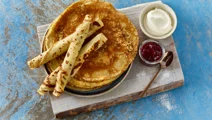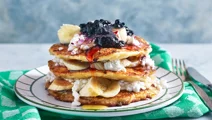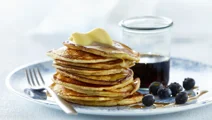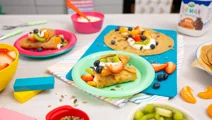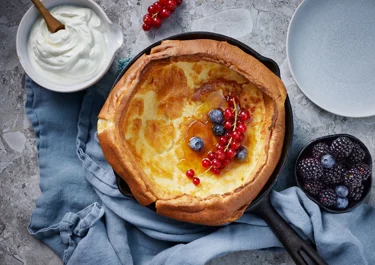
Dutch pancake with fresh berries

Instructions
Recommended information
Serving suggestion
Make a lighter and airier Dutch pancake
Achieving a light, airy Dutch pancake requires a few simple tricks. Start by whisking the batter until smooth and let it rest for about 10 minutes to allow the flour to absorb the liquid fully, which helps the pancake rise evenly. Another tip is to ensure your oven is fully preheated and very hot before baking, as the initial high heat creates steam, helping the pancake puff up. For extra lift, use room temperature eggs and milk, as this makes the batter smoother and helps it cook more evenly. The result is a light, golden Dutch pancake that’s crispy on the edges and fluffy in the centre.
Handle your pan with care
When making a Dutch baby pancake, your cast iron pan is essential, but it requires careful handling, especially when hot. Preheating the pan in the oven ensures even cooking, but remember to always use thick oven mitts or heat-resistant gloves when removing it, as the pan will be extremely hot. Place the pan on a sturdy, heatproof surface to avoid accidents. Swirl the melted butter carefully to coat the pan evenly, keeping your hands and face clear of any splatter. Avoid sudden temperature changes, such as placing a hot pan on a cold surface, as this could cause cracking.
Try using a blender for a smooth batter
For professional-level results with minimal effort, use a blender. Simply add the eggs, milk, flour, sugar, vanilla sugar, and salt directly into the blender and blend until the mixture is silky and well-combined. This method not only saves time but also ensures that the batter is perfectly smooth, eliminating any clumps of flour that might remain with hand mixing. Additionally, blending incorporates more air into the batter, which can help your Dutch pancake rise beautifully in the oven.
FAQ: Questions about our Dutch pancake recipe
Whether you're an experienced chef or a weekend kitchen enthusiast, mastering the Dutch pancake can bring a delightful twist to your cooking repertoire. In our FAQ section, we address some of the most common questions about this unique and adaptable dish, helping you make your next pancake fluffy and delicious.
Nutritional values
Nutritional value, per
765 Kcal
| Fibre | 0.8 gram fibers |
| Protein | 10.6 |
| Carbohydrates | 95.6 |
| Fat | 37.7 gram |
Ingredients
Eggs | 3 |
|---|---|
Plain flour | 85 g |
Icing sugar | 1 tbsp |
Vanilla sugar | ½ tsp |
Salt | ½ tsp |
Milk | 200 ml |
Butter | 3 tbsp |
To serve
Arla® Skyr Natural yogurt | 200 g |
|---|---|
Maple syrup | 50 ml |
Mixed fresh berries | handful |
What meals are suitable for serving a Dutch pancake?
Dutch pancakes are a wonderfully versatile dish that works well for a variety of meals. Traditionally enjoyed as a decadent breakfast or brunch option, it pairs perfectly with sweet toppings like fresh fruit, yogurt, maple syrup, or powdered sugar. It can also be transformed into a dessert by adding whipped cream, chocolate sauce, or caramelised nuts.
For a savoury twist, serve it for lunch or dinner with toppings like sautéed vegetables, cheese, or even smoked salmon. Its adaptable nature makes this recipe suitable for nearly any meal, whether you’re looking for a comforting breakfast or an elegant dinner.
Adjusting portion sizes for smaller skillets
If you’re using a smaller skillet for single servings, simply divide the batter evenly, ensuring each pan is no more than halfway full to allow room for the pancake to puff up as it bakes. Single portions typically require less batter, so aim for about 100-125 ml of batter per small skillet, depending on its size. The smaller pancakes will cook more quickly than a large one, so check for doneness a few minutes earlier than the recipe's recommended time. This approach is perfect for serving individual portions with customised toppings, making it ideal for breakfast gatherings or special occasions!
Selecting top-quality ingredients
Using top-quality, fresh ingredients is key to creating the perfect Dutch pancake. Start with fresh eggs – check by placing them in a bowl of water; if they sink and lie flat, they’re fresh, but if they float, it’s time to discard them. Choose high-quality unsalted butter to provide a rich, creamy flavour that forms the base of your pancake. For the best results, use pure vanilla sugar or a high-quality vanilla extract; these add a deeper, more natural sweetness that elevates the flavour of the batter. When choosing maple syrup, go for pure maple syrup rather than imitation varieties, as its rich caramel notes bring a luxurious touch to your pancake. Pair with fresh, ripe fruits or other toppings to create a dish that’s bursting with flavour and freshness.
Finishing touches for an elevated dining experience
Transform your Dutch pancake into a restaurant-worthy dish with a few simple finishing touches. Serve it straight from the skillet for a rustic, homely charm, or transfer it to a large plate for a more polished look. Garnish with a light dusting of powdered sugar, allowing it to settle naturally into the crevices. Arrange the fresh berries in an artful cluster or spiral pattern for a vibrant pop of colour. Finally, finish with edible flowers or a sprig of mint placed delicately on top, and serve it on a contrasting plate colour to make the dish visually striking and unforgettable.






